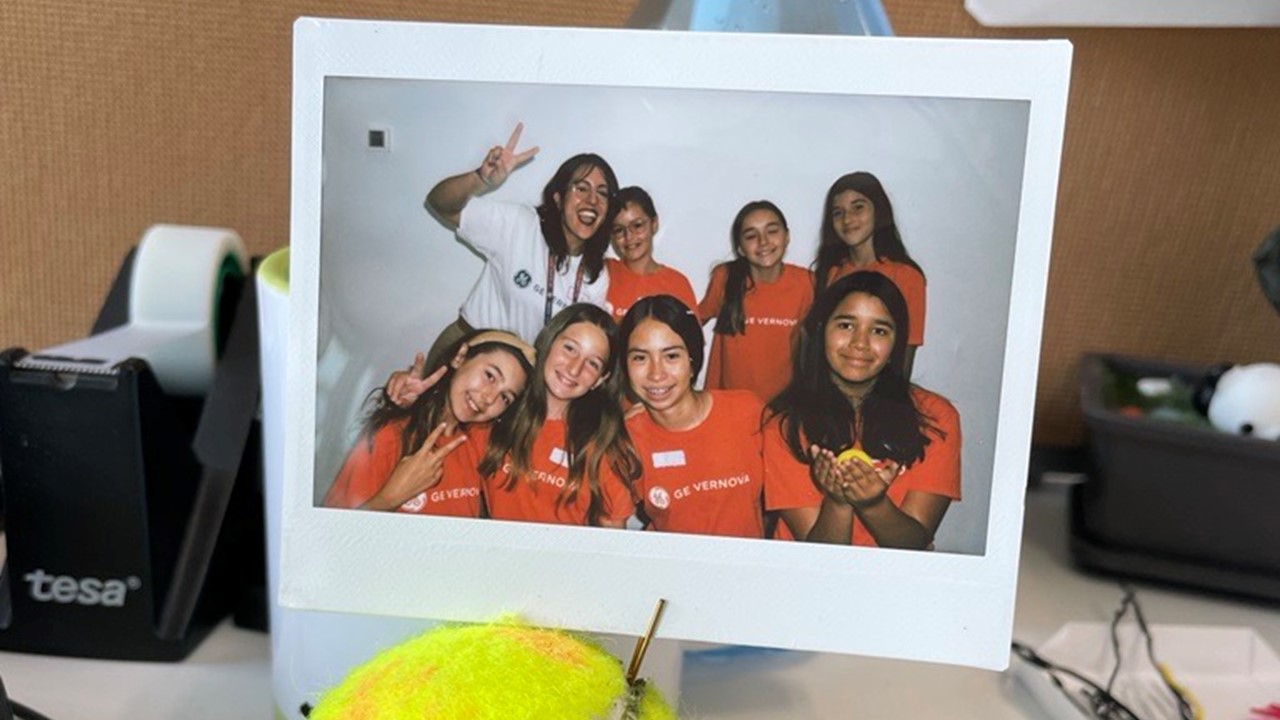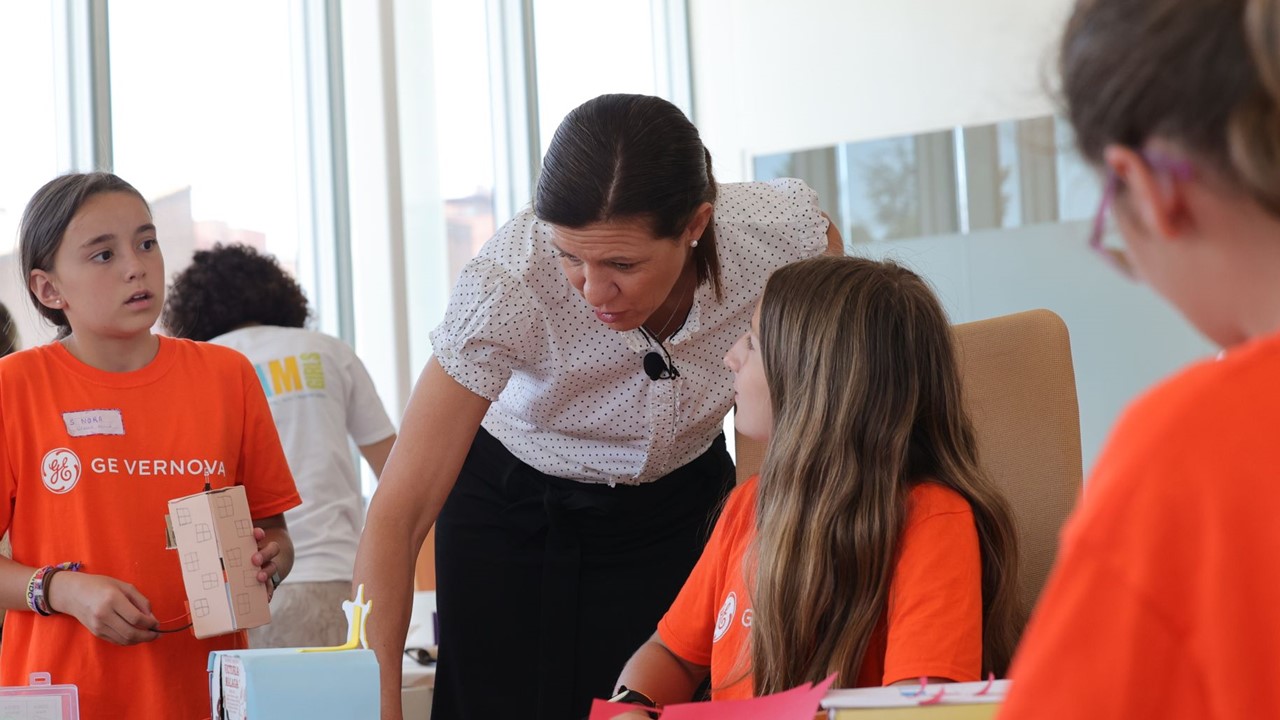Teaching a group of young girls to extract DNA from fruit — over videoconference, due to the pandemic — wasn’t in Miguel Angel Herranz del Pino’s job description. But the field operation process manager at GE Vernova in Madrid, Spain, stepped in two years ago when a co-worker was unable to take the class during the site’s first-ever STEAM Girls Spain Summer Camp. This year, Herranz del Pino was a camp counselor again, this time in person. If wrangling 10-year-old girls was challenging over Zoom, doing it live was even harder — but far more rewarding.
“It was particularly cool to show these girls all the things they can learn from a person who is really involved in this kind of job,” Herranz del Pino says. “I’ve always seen more boys than girls interested in science and engineering subjects. It’s a cultural issue we have carried as a society for years. Balancing the scales is a very healthy exercise, because better ideas emerge from diversity.”
The STEAM (science, technology, engineering, arts, and mathematics) camps were developed 14 years ago by the GE Women’s Network with the goal of encouraging more girls to consider careers in science and technology and, in the process, deepen the hiring pool for the company. Most girls drop traditional STEM classes by the time they get to high school, so organizers aimed at grabbing the interest of younger girls.
More than 4,000 campers aged 10 to 14 have gone through the camps since they were founded, and now GE Vernova is continuing the tradition by running its own camps.
“Just Labels”
This summer, GE Vernova hosted more than 300 campers and 100 volunteers in 16 countries. At the Madrid site, 41 girls and around 50 volunteers participated. One of them was Paola Campaña Sabonet, Europe continuous monitoring leader for the Gas Power business, at GE Vernova in Madrid. Campaña says she enjoyed being able to show the girls that things they learned in books had practical applications. “Seeing them realize they can do awesome stuff just by applying knowledge that they already know is something that I found very cool,” she says.
In Madrid, the camp activities included escape rooms, hydraulic arms, marble runs, Sphero robots, nuclear reactor models, and wind turbines. Campaña’s team started out learning about manufacturing by setting up a paper airplane factory. The seven girls were tasked with building 80 planes in five minutes. On the first iteration, no one made more than 15 airplanes. Then they regrouped, thought about it, and came up with a better idea: working together assembly-line style, just like a real plant. That allowed them to double the number of planes on their second try.

“It was very powerful, because they realized that doing things only slightly differently can change the outcome quite a lot,” Campaña says.
Campaña recalls having grown up without any female engineer role models. When she fell into the engineering field at her university, it was “like entering a dark place full of boys that I thought were smarter than me and who had a great advantage because they were being shown ‘the way’ from a young age,” she says. “They played construction games and built motorized toys. I know it’s a cliché, but I was bought Barbies, never a Lego set.”
Still, Campaña stuck with her career path. “Eventually I ended up enjoying the degree itself and proved to myself that those were just labels,” she says. “If I had had those role models much earlier, I probably wouldn’t have been so afraid. So making girls see that what might seem ‘foreign’ to them is within their reach — and is fun — is a huge motivator.”
“Learn Big, Enjoy Big, Dream Big”
Alma Sambade, the leader of Girls in STEAM for Spain, says she opened the camp every morning by asking the girls, “‘Who has the energy to change the world?’ I wanted to convey at all times: ‘Whatever you do in your life, remember to learn big, enjoy big, and dream big.’”
The STEAM Girls Summer Camps are a perfect example of the “One Team” philosophy that is a central pillar of the GE Vernova Way. As much as the company takes pride in encouraging more excitement and interest in the STEAM fields among these young women, the long game is about building a stronger company. As GE Vernova’s chief DEI officer, Reggie Miller, says, “Diversity, equity, and inclusion shouldn’t be seen as this separate thing that we have to do, but embedded in the way that we work on an everyday basis.”

In addition to camp activities, the girls were invited to visit GE Vernova sites to learn about the company’s business and meet women engineers. Meeting in person this year allowed the GE Vernova volunteers to get to know the girls better so they could tailor the activities to meet each one’s individual interests. Herranz del Pino’s team of seven girls built a small cardboard city powered by wind turbines. Individual buildings and streetlights within the city were equipped with LEDs that lit up when someone blew on a wind turbine. Some of the girls were more interested in designing and decorating the buildings, while others wanted to run the cables that ran from the wind turbines to the lights. Herranz del Pino gave them license to build the city however they wanted and work on the part of the project that most appealed to them.
“Some were really artistic, so we ended up with the prettiest wind turbines and houses and even hot dog stands,” he says. “One of the houses had a cat sitting on the roof, and one girl drew the company logo for the power plant in about two seconds. It was fun seeing them really getting into what was most interesting to them.”
For Herranz del Pino, who spends most of his days in the solitary job of coding, spending all day with the girls was fun, but draining. “I’d get in the car and ask my wife if we could just not talk on the way home,” he says, laughing. “But I will definitely do it all again.”
Read our other recent stories about some remarkable women engineers: Veronica Barner, head of research and development for Renewable Energy at GE Vernova, and Vera Silva, the chief strategy and technology officer of GE Vernova’s Electrification Systems.